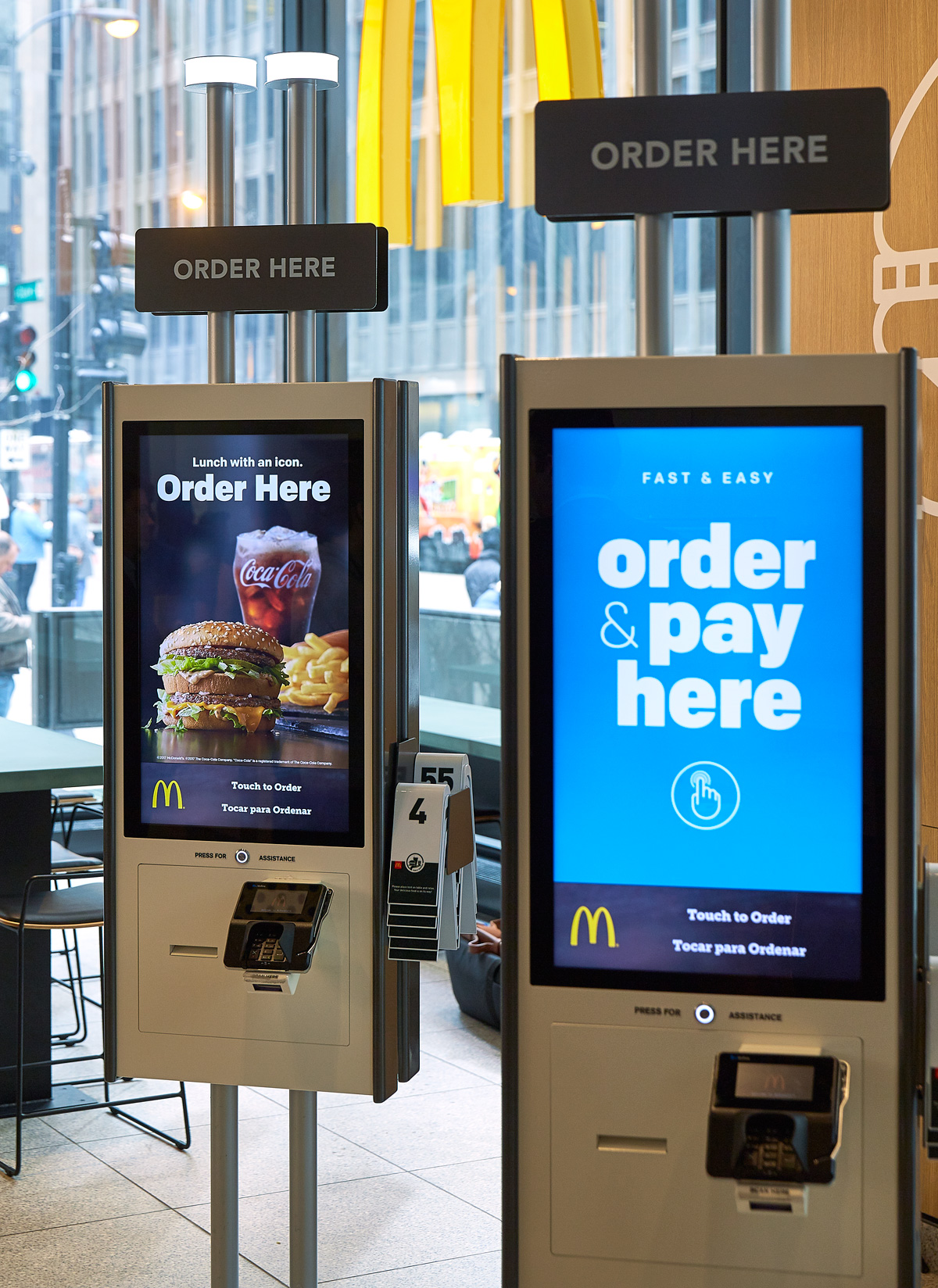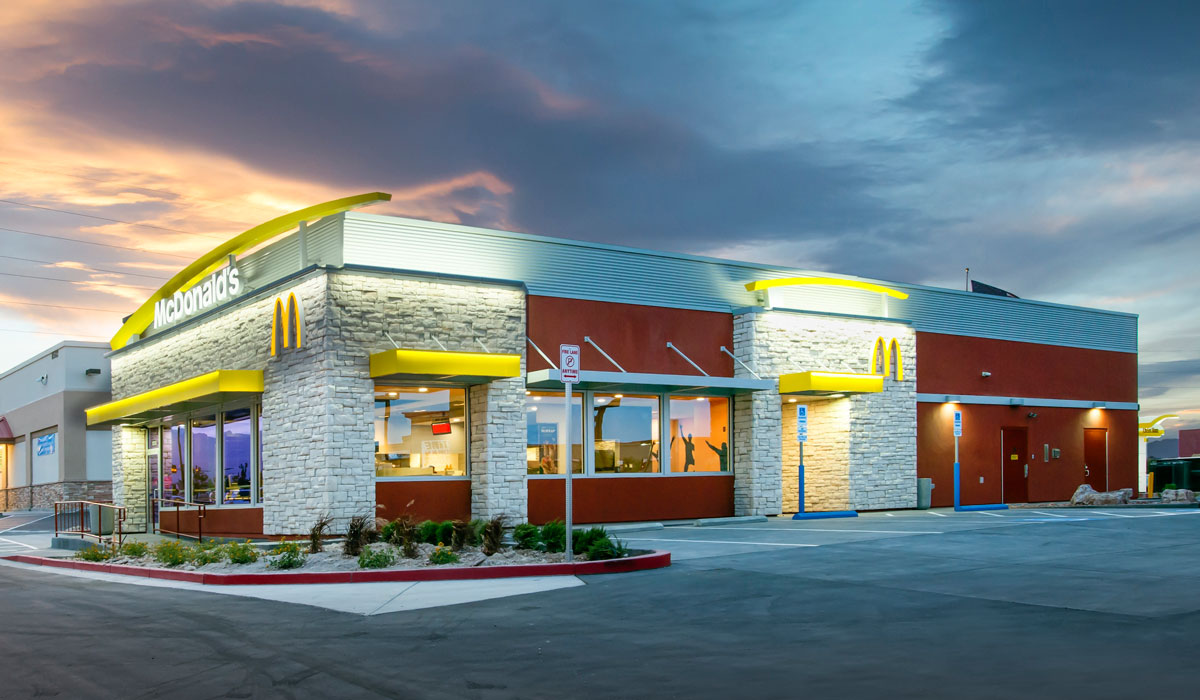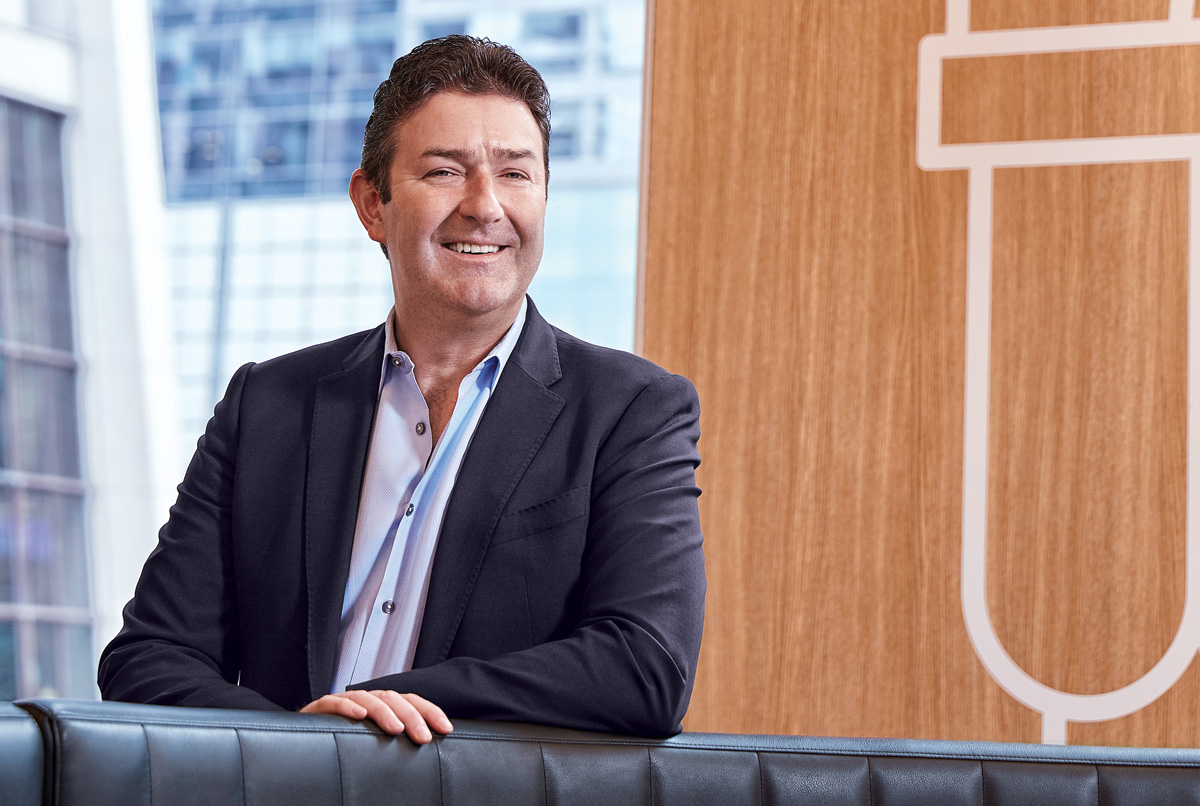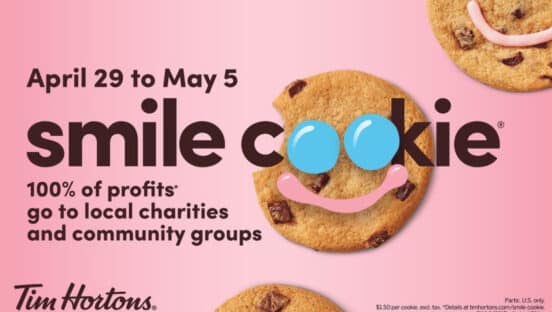On May 4, 2015, Steve Easterbrook announced himself to the world.
Newly minted as McDonald’s CEO—just two months after taking over for Don Thompson—Easterbrook starred in an online video in which he outlined a Turnaround Plan for the world’s most successful restaurant company, which at the time had experienced six consecutive quarters of declining same-store sales. Staring directly at the camera for the video’s 23-minute duration, Easterbrook acknowledged where McDonald’s had strayed as a business and what it would do to correct course, saying things like “I will not shy away from the urgent need to reset this business,” and, “We will look to create more excitement around the brand.”
While Easterbrook’s plan felt like a step in the right direction, even reminiscent of former CEO Jim Skinner’s successful “Plan to Win” from the early 2000s, the video didn’t exactly inspire confidence. A CNN commentator said there weren’t enough specifics. Mashable called it “passionless.” And a Forbes contributor bemoaned the mea culpa as being “spectacularly awful.” The company’s stock dipped in the wake of the video’s release.
It felt, at least in the moment, as if McDonald’s might once again have floundered as an irrelevant dinosaur in an ever-modernizing world.
But three years into the Turnaround Plan, Easterbrook is having the last laugh. McDonald’s stock price is up more than 60 percent since the plan’s release. Sales comps are back in the black, with 2017 offering the best sales growth in six years. And sure enough, there’s an undeniable excitement surrounding McDonald’s as it invests in new technology initiatives, customer experiences, and corporate responsibility.
And it doesn’t take Easterbrook 23 minutes to sum up what the company got right in the plan.
“It’s not about being a different McDonald’s,” he says on a chilly March day in a downtown Chicago store, sipping a latte as he details the Turnaround Plan’s success. “It’s about being a better McDonald’s.”
Shortening the pipeline
By most measures, Easterbrook was a conventional CEO pick for McDonald’s. He’s a company man, having started with the Golden Arches as a financing manager when he was in his 20s. His immediate past position was that of global chief brand officer, a role that allowed him deep insights into the McDonald’s image and experience. He’s polished, confident, and smart.
These latter characteristics are clearly on display as Easterbrook sits down for a wide-ranging interview, streams of Chicago commuters passing by in one of McDonald’s tech-forward Experience of the Future stores. Also on display? His smooth British accent, a reminder that in some ways Easterbrook was an unconventional CEO choice. Born in England, Easterbrook worked up the McDonald’s ranks before he spent nearly five years heading the company’s U.K. and Europe division. He then left McDonald’s for two separate CEO stints—first at Pizza Express, then at Wagamama, both U.K.-based restaurant companies—before rejoining McDonald’s in 2013.
That rounded, global perspective has become one of the aces up Easterbrook’s sleeve during his CEO tenure.
“I think Europe had been on the sharp end of that shift in consumer expectation and had embraced it and adapted to it,” he says of how his days overseeing the Europe business lent him a distinct advantage. “The confidence of seeing that work in many mature markets, how we could continually evolve the business and the brand, gave me the confidence that it was absolutely transferable knowledge and skills that we could share elsewhere in the McDonald’s global system, particularly here in the U.S.”
The Turnaround Plan Easterbrook laid out in May 2015 was a mix of both tangible and intangible evolution. While the plan carried some specific directives—including a global restructuring plan and a refranchising initiative designed to save the company some $300 million—there were others that were a bit harder to define.
Chief among those, Easterbrook says, was a cultural change. The brand was tired and the company’s confidence was ebbing away, he says, reducing management’s appetite for risk.
“One thing I tried to introduce with urgency from early on was the need for a mind shift or change in attitude, recognizing that what had made us successful for our first 60 years wasn’t necessarily going to be sufficient to make us successful for our next 60,” he says. “It was to create a sense of urgency … that we needed to adopt a different approach.”
The global restructuring was the first building block in that different approach. Before the Turnaround Plan, McDonald’s global system was divided by geographic region. The new model divides the global system instead by market stages, with four groups: U.S., International Lead Markets (mature global markets with similar economic and competitive dynamics), High-Growth Markets (markets with more growth potential), and Foundational Markets (remaining markets, including corporate activities).
Easterbrook says these changes stripped several layers of bureaucratic management from the global McDonald’s system.
“We had pockets of brilliance all over the place, but we hadn’t necessarily pulled it all together or allowed that knowledge transfer as quick as we wanted it,” Easterbrook says. “It’s at a level now where I will have one segment president between me and a market. Previously there could have been up to five people in that chain of management.”
“The reality is a strategy can be fantastic, but if you don’t execute it well, it becomes worthless. I’ll always say that an 80 percent perfect strategy executed 100 percent is way better than a perfect strategy executed at 80 percent. And the execution happens at the restaurant level, the vast majority through our franchisees.” — Steve Easterbrook, McDonald’s CEO.

That shorter idea pipeline has boosted some of McDonald’s strongest ideas in the last three years. Easterbrook points to menu innovations, restaurant design, and new technologies as being examples of ideas that can now be exchanged more quickly. The kiosk ordering platform that’s the star of McDonald’s Experience of the Future store prototype? It first took off in France. And delivery was popular in Asia and the Middle East long before McDonald’s inked a deal with UberEats in the U.S.
Along with the restructuring, McDonald’s corporate office also experienced a shake-up. Not only did the company announce a headquarters move from suburban Oak Brook to Chicago’s trendy downtown West Loop neighborhood, but also several staff positions were eliminated, and many high-profile executives—including CMO Deborah Wahl, president of high-growth markets Dave Hoffmann, chief digital officer Atif Rafiq, and executive chef Dan Coudreaut—departed. Meanwhile, new hires like U.S. president Chris Kempczinski and CMO Morgan Flatley joined from Kraft and PepsiCo, respectively.
R.J. Hottovy, senior retail and restaurant analyst with investment research company Morningstar, says this corporate overhaul allowed McDonald’s—and Easterbrook’s plan—a sorely needed fresh start.
“He brought in some outside talent, people who had different approaches to getting to the end goal, and I think you’re seeing the results—definitely more of a high level of execution and new idea generation,” Hottovy says. “Executing at a much higher level is a huge testament to what Steve’s brought in.”
‘A modern, progressive burger company’
One of the chief complaints about McDonald’s during Thompson’s tenure as CEO was that the menu had become too bloated. According to Datassential numbers reported in 2013, the menu had expanded by 70 percent to 145 items between 2007 and 2013. Premium menu items designed to compete with the elevated offerings of the fast-casual segment, like Angus burgers and Premium McWraps, never took off.
Critics of the brand’s menu problems were not assuaged by Easterbrook’s 23-minute video, as the CEO offered scant details on how McDonald’s would improve that area of the business other than to say that it would focus on being “a modern, progressive burger company.” But the last three years have offered plenty of evidence that McDonald’s still sees its menu as a differentiator in the fight for customers’ dollars.
The company recommitted to its core product offerings and simplified the menu by removing some underperforming and overly complex items. It also pledged to invest in better ingredients, including chicken raised without antibiotics important to human medicine (which it will phase in globally by 2027 but has already completed in the U.S.) and cage-free eggs (which it will phase in by 2025), while also removing corn syrup from hamburger buns and artificial preservatives from items like Chicken McNuggets. And last year McDonald’s announced it would start to roll out fresh beef patties for its Quarter Pounders; as of March, fresh beef was offered in 3,500 U.S. locations, with the rest of the country expected to follow by early May.
“The narrative is cleaner eating,” says Jeremy Scott, a restaurant analyst with financial services firm Mizuho. “It’s stuff like that that they probably recognized a little too late versus the rest of the industry, but now they’re making the right investments.”
McDonald’s hasn’t given up on developing premium menu items, though. In early 2017, the brand launched its Signature Crafted Recipes line, which included Pico Guacamole, Sweet BBQ Bacon, and Maple Bacon Dijon sandwiches, available with either beef or grilled or crispy chicken. Another addition was the Buttermilk Crispy Chicken Tenders, which were so popular the company had to briefly pull them from the menu.
To some degree, Easterbrook’s plan has doubled down on what McDonald’s customers expect from the brand rather than strived to be something more—a common tease that many quick serves succumbed to in the first half of this decade as they faced the increasing threat from fast casuals. When asked how McDonald’s can maintain an iconic American brand status in an age of lifestyle brands like Apple and Google, Easterbrook answers with what can only be described as humility.
“We’re not a life-transforming business to many of our customers, but we can make their lives more fun, more convenient, more enjoyable on an everyday basis,” he says. “What does that look like in the modern world, when you’ve got these tech giants who are transforming lifestyles in certain ways? Let’s not set out to try to transform lives, but let’s face the strengths that we have.”

One of those strengths was McDonald’s breakfast menu, and the company faced that strength with aplomb when it announced in 2015 that it would answer customer demand by offering its breakfast menu all day. The All Day Breakfast launch in October of that year provided McDonald’s with some of its best buzz in the Easterbrook era and finally gave the company the sales jolt it desired; 2015 fourth-quarter comparable sales grew 5.7 percent.
Easterbrook says much of McDonald’s turnaround has been designed around the concept of choice—giving customers more choice in what they order, how they order, how they pay, and how they’re served—with the ultimate goal being to bring in more customers more often. After all, the eating-out industry is only growing marginally, Easterbrook says.
“A lot of that growth will come from new units, either new concepts coming in or people expanding,” he says. “Which means, if you really want to grow your business—serve more customers more often—it’s a market share fight. It’s as simple as that. So how do you win that market-share fight?”
The answer? Value menus. At the beginning of this year, McDonald’s announced its $1 $2 $3 Dollar Menu, which features a range of items at each of those price points. The revised menu follows in the wake of McPick 2 (two items for $5) and Dollar Menu & More value menu options, two platforms that failed to create the same excitement for guests as the brand’s iconic Dollar Menu, which was scrapped in 2013.
“We can grow topline sales if we do that solely through average check growth, which could be through product makeshift or through price,” Easterbrook says. “That can give you some short-term results, but the long-term health of our business, the lifeblood of our business, is serving more customers more often. That has really helped us internally move from talking about being customer-driven to actually thinking about being customer-obsessed.”
So far, response to the $1 $2 $3 Dollar Menu has been varied. There’s been the typical grumbling from franchisees who worry a focus on value will eat into their profit margins, and McDonald’s stock price tumbled in March when it was revealed that first-quarter sales were softer than expected.
But Mizuho’s Scott says it’s a long-term play that’s necessary in the fight for quick-service traffic. “If you suck the oxygen out of the room with a value plan, that short-term pain is long-term gain, if that value plan is operated consistently,” he says. “I think [McDonald’s is] making the right moves to suck out the oxygen, in large part because we’ve seen so much pricing action from the high-end, fast-casual segment, and this could be a way to put the knife in the side, especially as the fast-casual industry is starting to roll over.”
Stepping on the accelerator
By 2017, Easterbrook’s Turnaround Plan had already started to take hold; global comparable sales were up 3.8 percent in 2016. But the company acknowledged that between 2012 and 2017, it had lost a potential 500 million customer transactions to its competitors. Something needed to be done to build on the momentum of the Turnaround Plan.
For McDonald’s, that something was the Velocity Growth Plan, which rolled out in March 2017. Easterbrook says the company spent 2015 and 2016 demonstrating its regained footing, but with the Velocity Growth Plan, it aimed to push the brand even further into the future.
“We looked at ourselves and thought, if we’re creating a world-class team to lead a world-class business, does a steady growth plan meet our expectations? And of course, our ambitions are greater than that,” Easterbrook says. “So we challenged ourselves to say, are there additional growth drivers that we can put on top of our traditional growth plan, which would really accelerate growth?”
Those growth accelerators were the Experience of the Future store prototype, delivery in partnership with UberEats, and customer-forward tech platforms like the mobile order and pay app functionality.
The Experience of the Future prototype is perhaps one of the most glaring examples of how McDonald’s is reshaping its business for the future. Originally launched in the Thompson era as Create Your Taste, the touch-screen kiosk ordering platform allows guests the choice of ordering their meals digitally and grabbing a number for their table rather than interacting with an employee. The first iteration launched under Thompson was intended to spotlight customization—customers could select from more than 30 ingredients in building their own burgers. But under the Experience of the Future banner, it has been refined to simply offer guests more choice in the McDonald’s menu (for example, removing pickles from their Big Mac).
The mobile order and pay app, which rolled out nationwide over the course of 2017, offers that opportunity from the comfort of customers’ smartphones. They can then pick their food up at the counter, in the drive thru, or through a new curbside pick-up option.
Easterbrook says one of the company’s struggles leading into the Turnaround Plan was that it had directed most of its technology focus on back of the house rather than on customer-facing initiatives. “We didn’t have that one-on-one connectivity with customers that we know would make us a much more valuable commodity to customers if we understood their behavior,” he says. Some of that connectivity is yet to come, he adds; McDonald’s will move to become a “mass personalization” brand that can, for example, suggest returning guests’ regular orders or even offer relevant sports scores as the guest orders.
The delivery partnership with UberEats, meanwhile, has been the biggest cultural change for McDonald’s in the last few years, Easterbrook says. He and other members of the senior team had been so inspired by their travels to international locations that they decided delivery was something the company needed to embrace. Rather than wait for the perfect solution, he says, McDonald’s dove right in, with leadership trusting they would learn quickly.
The delivery rollout was aggressive. What started as a 20-store test in Miami in January 2017 expanded to more than 7,000 restaurants in 21 countries at press time, including 5,000 in the U.S. (UPDATE: In McDonald’s Q1 earnings call, Easterbrook reported that 11,500 restaurants now offer delivery. “Whilst we continue to expand the base of participating restaurants, we are working closely with UberEats and our other partners to optimize the model … building awareness, trial, and more frequent repeat orders … and, most importantly, customer and courier satisfaction,” he said on the call. “In most of our major markets, delivery is already a meaningful contributor to overall comparable sales.”)
“I think that’s probably the best example of how we rallied the broader system just to embrace an opportunity and go hard at it, rather than the slightly more methodical, incremental way that perhaps we would have done in the past,” Easterbrook says. “It still doesn’t mean we’re perfect, but we’re better now than we were a year ago, and we’ll be better in a year’s time than where we are today, because we continued to improve and learn as we go.”
McDonald’s is still in the midst of the Velocity Growth Plan, but Easterbrook says “the early signs are encouraging.” At the beginning of 2018, the company had updated about 3,000 U.S. locations to the Experience of the Future design and was on pace to update almost 4,000 additional locations this year. Nearly all U.S. locations will feature the new prototype by 2020.
“We’ve still got a lot of legs to actually get done what we’ve laid out in the Velocity Growth Plan,” he says. “But I’d be lying if I didn’t tell you that a small number of us have begun to think what’s over and above that. And I think that’s what people expect out of leadership.”
The ever-faster pace
Last year offered the starkest evidence yet that Easterbrook had done the seemingly impossible: He’d successfully drawn up the blueprint for a massive McDonald’s turnaround. Global comparable sales were up 5.3 percent in 2017, and comparable guest counts were positive for a full year for the first time since 2012.
Mizuho’s Scott says Easterbrook managed to turn McDonald’s from a brand that reacted to broader consumer changes into one that could anticipate them.
“Him coming in and saying, ‘Why aren’t we doing this? Why aren’t we making the changes that customers want?’ was more of a change in the way they approach business—getting on the inside track of some of the customer-focused items that they in the past may not have really focused on,” he says.
Perhaps the most important stakeholder to this success is McDonald’s global network of franchisees, which is only growing larger. One of the core tenets of the Turnaround Plan was a refranchising initiative in which McDonald’s planned to increase the share of its locations that were franchised from 81 percent of the system to more than 90 percent. It aimed to refranchise 4,000 restaurants by the end of 2018 but completed the goal a year ahead of schedule, thanks partly to a transaction involving locations in China and Hong Kong.
While the refranchising allowed the company to save about $300 million in general and administrative expenses, CFO Kevin Ozan also said at the completion of the initiative that it brings McDonald’s closer to the customers and communities and “creates a better opportunity to unlock their full growth potential.”
Indeed, as with most other quick-service brands that are mostly franchised, McDonald’s is run at the ground level by a vast group of men and women who operate as small businesses. This isn’t lost on Easterbrook, who says franchisees are “everything about the turnaround” and that they “want to be brought on that journey.” McDonald’s ability to succeed at this massive turnaround, he adds, is much higher with their buy-in.
“The reality is a strategy can be fantastic, but if you don’t execute it well, it becomes worthless,” he says. “I’ll always say that an 80 percent perfect strategy executed 100 percent is way better than a perfect strategy executed at 80 percent. And the execution happens at the restaurant level, the vast majority through our franchisees.”
He says his job, along with that of the senior-level management team, is to focus on the long-term plan for the company while the owner-operators focus on the short- to medium-term. To accomplish that, it’s critical to keep an eye on where the customer is today and where the customer is going in the future.
“The world is moving at an ever-faster pace, and today’s the slowest the world’s ever going to move, but today is also the quickest it’s ever moved so far,” he says. “That’s just the conundrum we have.”
No pressure, right? No, actually—at least, not according to Easterbrook. If you get the best out of the people around you, he says, then you’re doing the best you can. And at McDonald’s, it’s the best the company has been in a long, long time.
“If I was to use a baseball analogy, we’ve probably just rounded first base,” he says. “I’m excited about what’s to come.”





